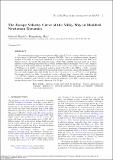Files in this item
The escape velocity curve of the Milky Way in Modified Newtonian dynamics
Item metadata
| dc.contributor.author | Banik, Indranil | |
| dc.contributor.author | Zhao, Hongsheng | |
| dc.date.accessioned | 2017-09-12T16:30:12Z | |
| dc.date.available | 2017-09-12T16:30:12Z | |
| dc.date.issued | 2018-01 | |
| dc.identifier | 251032478 | |
| dc.identifier | 247dfbcb-39d1-4708-a227-d31a8f055a09 | |
| dc.identifier | 85041103516 | |
| dc.identifier | 000415653600035 | |
| dc.identifier.citation | Banik , I & Zhao , H 2018 , ' The escape velocity curve of the Milky Way in Modified Newtonian dynamics ' , Monthly Notices of the Royal Astronomical Society , vol. 473 , no. 1 , pp. 419-430 . https://doi.org/10.1093/mnras/stx2350 | en |
| dc.identifier.issn | 1365-2966 | |
| dc.identifier.other | ORCID: /0000-0002-4123-7325/work/36661755 | |
| dc.identifier.uri | https://hdl.handle.net/10023/11648 | |
| dc.description | IB is supported by Science and Technology Facilities Council studentship 1506672. | en |
| dc.description.abstract | We determine the escape velocity from the Milky Way (MW) at a range of Galactocentric radii in the context of Modified Newtonian Dynamics (MOND). Due to its non-linear nature, escape is possible if the MW is considered embedded in a constant external gravitational field (EF) from distant objects. We model this situation using a fully self-consistent method based on a direct solution of the governing equations out to several thousand disk scale lengths. We try out a range of EF strengths and mass models for the MW in an attempt to match the escape velocity measurements of Williams et al. (2017). A reasonable match is found if the EF on the MW is ∼0.03a0, towards the higher end of the range considered. Our models include a hot gas corona surrounding the MW, but our results suggest that this should have a very low mass of ∼2 × 1010M⊙ to avoid pushing the escape velocity too high. Our analysis favours a slightly lower baryonic disk mass than the ∼7 × 1010M⊙ required to explain its rotation curve in MOND. However, given the uncertainties, MOND is consistent with both the locally measured amplitude of the MW rotation curve and its escape velocity over Galactocentric distances of 8−50 kpc. | |
| dc.format.extent | 12 | |
| dc.format.extent | 646395 | |
| dc.language.iso | eng | |
| dc.relation.ispartof | Monthly Notices of the Royal Astronomical Society | en |
| dc.subject | Galaxies: groups: individual: Local Group | en |
| dc.subject | Galaxy: kinematics and dynamics | en |
| dc.subject | Dark Matter | en |
| dc.subject | Methods: numerical | en |
| dc.subject | Methods: data analysis | en |
| dc.subject | Cosmology: cosmological parameters | en |
| dc.subject | QB Astronomy | en |
| dc.subject | QC Physics | en |
| dc.subject | Astronomy and Astrophysics | en |
| dc.subject | NDAS | en |
| dc.subject.lcc | QB | en |
| dc.subject.lcc | QC | en |
| dc.title | The escape velocity curve of the Milky Way in Modified Newtonian dynamics | en |
| dc.type | Journal article | en |
| dc.contributor.institution | University of St Andrews. School of Physics and Astronomy | en |
| dc.identifier.doi | https://doi.org/10.1093/mnras/stx2350 | |
| dc.description.status | Peer reviewed | en |
| dc.identifier.url | https://arxiv.org/abs/1708.03771 | en |
| dc.identifier.url | https://academic.oup.com/mnras/article/473/1/419/4111174?guestAccessKey=94a4893e-4bbc-4157-8930-2815735b1692 | en |
This item appears in the following Collection(s)
Items in the St Andrews Research Repository are protected by copyright, with all rights reserved, unless otherwise indicated.

